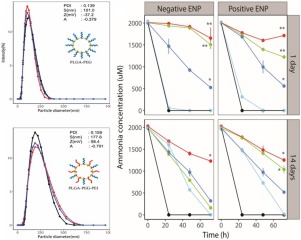当前位置:
X-MOL 学术
›
J. Ind. Eng. Chem.
›
论文详情
Our official English website, www.x-mol.net, welcomes your feedback! (Note: you will need to create a separate account there.)
The Effect of Engineered PLGA Nanoparticles on Nitrifying Bacteria in the Soil Environment
Journal of Industrial and Engineering Chemistry ( IF 6.1 ) Pub Date : 2020-04-01 , DOI: 10.1016/j.jiec.2020.01.011 Susmita Das Nishu , Seungbin Park , Yuhyun Ji , Il Han , Jaehong Key , Tae Kwon Lee
Journal of Industrial and Engineering Chemistry ( IF 6.1 ) Pub Date : 2020-04-01 , DOI: 10.1016/j.jiec.2020.01.011 Susmita Das Nishu , Seungbin Park , Yuhyun Ji , Il Han , Jaehong Key , Tae Kwon Lee

|
Abstract As a result of their biodegradability and biocompatibility, various nanoparticles using poly(lactic-co-glycolic acid) (PLGA) as a copolymer have shown promising results in biomedical engineering fields, including molecular imaging and drug delivery. However, the potential nanotoxicity of PLGA-based nanoparticles in the environment was poorly understood. Measurement of bacterial nitrification activities and changes in the soil microbial community are both critical parameters that should be used to evaluate potential distrurbances in the functioning of the environmental ecosystem. This study aimed to investigate the impact of PLGA nanoparticles with different zeta-potentials on nitrifying bacterial communities in the soil environment. In pure culture studies, the ammonia oxidation was inhibited by higher than 50% when PLGA cocentration is more than 0.05 mg/L or more regardless of zeta potential and exposure time, but the negligible effects were observed on the nitrite oxidation by most conditions. In the soil microcosm experiment, at the 0.05 concentration of the oparticles, the ammonia and nitrite oxidation were inhibited by more than 50% on the first day regardless of the nanoparticle composition, but all the activity was recovered after 14 days. These results provide a fundamental information on the toxcity of PLGA nanparticles on ecologcial function.
中文翻译:

工程化 PLGA 纳米颗粒对土壤环境中硝化细菌的影响
摘要 由于其可生物降解性和生物相容性,使用聚乳酸-乙醇酸共聚物 (PLGA) 作为共聚物的各种纳米粒子在生物医学工程领域显示出可喜的成果,包括分子成像和药物递送。然而,基于 PLGA 的纳米粒子在环境中的潜在纳米毒性知之甚少。细菌硝化活动的测量和土壤微生物群落的变化都是评估环境生态系统功能潜在干扰的关键参数。本研究旨在研究具有不同 zeta 电位的 PLGA 纳米粒子对土壤环境中硝化细菌群落的影响。在纯文化研究中,当PLGA浓度大于0.05mg/L或更高时,无论zeta电位和暴露时间如何,氨氧化均被抑制高于50%,但在大多数条件下观察到对亚硝酸盐氧化的影响可以忽略不计。在土壤微观实验中,在0.05浓度的oparticles中,无论纳米粒子的组成如何,第一天氨和亚硝酸盐的氧化被抑制了50%以上,但14天后所有的活性都恢复了。这些结果提供了关于 PLGA 纳米颗粒对生态功能的毒性的基本信息。无论纳米颗粒的成分如何,氨和亚硝酸盐的氧化在第一天被抑制了 50% 以上,但所有活性在 14 天后恢复。这些结果提供了关于 PLGA 纳米颗粒对生态功能的毒性的基本信息。无论纳米颗粒的成分如何,氨和亚硝酸盐的氧化在第一天被抑制了 50% 以上,但所有活性在 14 天后恢复。这些结果提供了关于 PLGA 纳米颗粒对生态功能的毒性的基本信息。
更新日期:2020-04-01
中文翻译:

工程化 PLGA 纳米颗粒对土壤环境中硝化细菌的影响
摘要 由于其可生物降解性和生物相容性,使用聚乳酸-乙醇酸共聚物 (PLGA) 作为共聚物的各种纳米粒子在生物医学工程领域显示出可喜的成果,包括分子成像和药物递送。然而,基于 PLGA 的纳米粒子在环境中的潜在纳米毒性知之甚少。细菌硝化活动的测量和土壤微生物群落的变化都是评估环境生态系统功能潜在干扰的关键参数。本研究旨在研究具有不同 zeta 电位的 PLGA 纳米粒子对土壤环境中硝化细菌群落的影响。在纯文化研究中,当PLGA浓度大于0.05mg/L或更高时,无论zeta电位和暴露时间如何,氨氧化均被抑制高于50%,但在大多数条件下观察到对亚硝酸盐氧化的影响可以忽略不计。在土壤微观实验中,在0.05浓度的oparticles中,无论纳米粒子的组成如何,第一天氨和亚硝酸盐的氧化被抑制了50%以上,但14天后所有的活性都恢复了。这些结果提供了关于 PLGA 纳米颗粒对生态功能的毒性的基本信息。无论纳米颗粒的成分如何,氨和亚硝酸盐的氧化在第一天被抑制了 50% 以上,但所有活性在 14 天后恢复。这些结果提供了关于 PLGA 纳米颗粒对生态功能的毒性的基本信息。无论纳米颗粒的成分如何,氨和亚硝酸盐的氧化在第一天被抑制了 50% 以上,但所有活性在 14 天后恢复。这些结果提供了关于 PLGA 纳米颗粒对生态功能的毒性的基本信息。


























 京公网安备 11010802027423号
京公网安备 11010802027423号